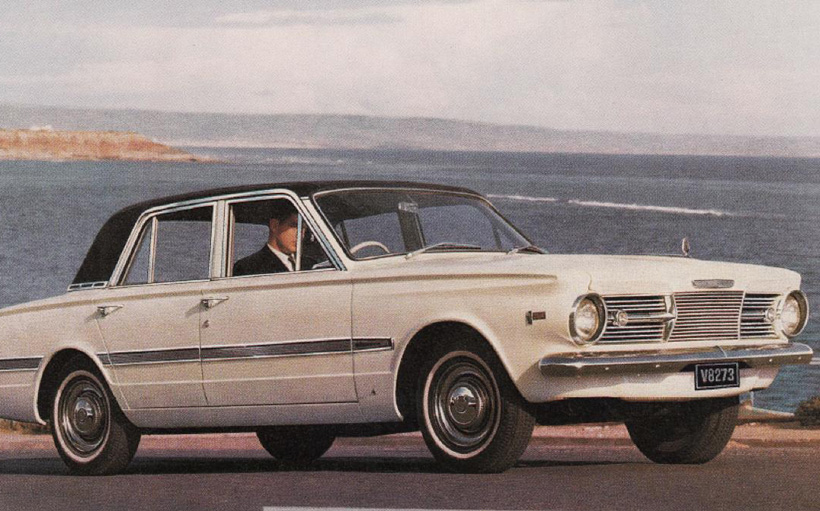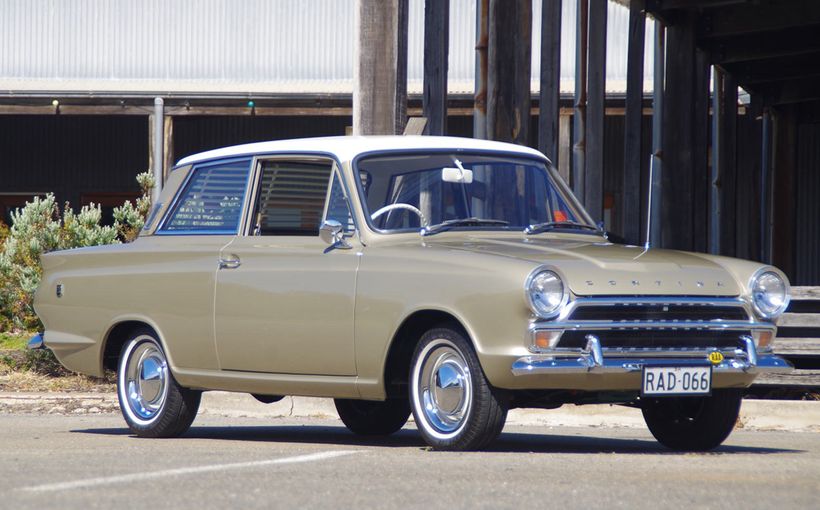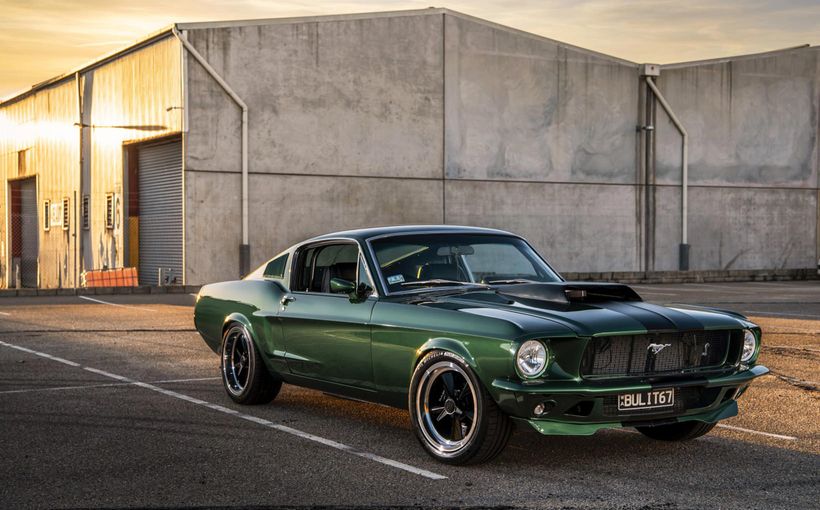AP6/VC Valiant V8: More Power to Australians

Even if the August 1965 launch of Australia’s first compact V8 family car didn’t set off fireworks around the country, it should have. In just over two years, local top-shelf motoring went from the 2.3-litre 75bhp/56kW Holden EJ Premier to the ground-shifting 4.5-litre 180bhp/134kW AP6 Valiant V8.
Unlike the big and heavy US V8 models that came before it, the new Valiant V8 was unusually light and agile and the perfect size to exploit its extra performance on narrow Australian roads. Its 273/4.5-litre V8 engine was also state of the art reflecting the latest developments in thin wall casting that slashed engine weight to within 22kg of the six.
Because Chrysler Australia took advantage of the V8’s shorter engine length and moved it to the back of the engine bay, the handling balance was not compromised.
The new AP6 styling and the AP7/VC facelift that followed were both unusually glamorous after Australian designers were given the go-ahead to go it alone and distinguish the local Valiant further from its rivals.

The AP6/VC Valiant
After Australians were wooed by the striking styling of the R and S Series Valiants, the first Australian model, the 1963 AP5, was a huge let down. Virgil Exner, responsible for the wild and adventurous look of Chryslers up to that point, had been dismissed.
His replacement, ex-Ford man Elwood Engel, had been charged with making Chryslers look more mainstream and simpler to build. The 1963 US Valiant was a transition model with sloping bootlid, small fins, curved rear window and separate grille. Although it did not generate such a stark contrast with the outgoing S Series, Australian management was concerned that it would not offer enough boot space for its premium local family car positioning.
The bootlid was raised to the same level as the US car’s fins while the C-pillars were beefed-up and filled with a flat rear screen. This not only cut costs but shielded rear passengers from the sun.

For reasons never made entirely clear, the semi-covered rear wheel arches on the US model were left fully open. These local rear wheel arches not only matched the fronts but were similar to the R and S Series. The rear bumper extension pressing in the rear quarters was also deleted.
Was it to save on tooling, or to provide easier access for changing the larger local 14 inch wheels or was it to provide some relief for the heavier-looking rear quarters of the Australian body? Or was it as simple as aligning the rear wheel arches of the local sedan with the US wagon ready for grafting the wagon panels to the local car?
Combined with the AP5’s simple slat grille and the extruded side strips on the Regal, it looked like Chrysler had cut costs by sourcing bits from venetian blinds and carpet-edging. Against the EH Holden and XL/XM Falcon, the AP5 Valiant seemed to be an amalgam of both cars without offering anything truly different, as defined by previous Valiants.
The AP6 facelift, while simple, returned some of that individuality at a time when Ford and Holden were offering new models that looked quite different. Although the AP6 grille and front guards now seemed to line-up with the 1965 US model, the front was very different in detail including the centre grille shape and grille-mounted indicators. The painted centre grille section was also a premium US feature and brought back welcome memories of earlier separate grilles.

The AP6 Regal’s side trim was a class act, now looking as though it had been specifically tooled for a car. The AP6’s upgraded appearance could now support an unrivalled premium V8 model, only to have that niche snatched away by the long wheelbase Fairlane two years later.
The AP6 and VC were therefore arguably the last Valiants to enjoy a tangible lead over their local rivals. For that reason, both models are enjoying renewed interest and a well-deserved increase in values.
As the first standard wheelbase local models to offer a V8 model, they are at least as significant as the first Falcon GT which in 1967 was a Bathurst homologation model. The Falcon GT would have to wait until the XT in 1968 to become a mainstream model.

The Valiant V8 as it was called, was NOT a Regal. As a sedan, it was a standalone model that shared some Regal exterior details but the badging was different. It was the first Australian car to offer a vinyl roof as standard. It was also the first to offer a centre console housing a floor selector for the automatic transmission.
The imported bucket seats were true buckets trimmed in the most lavish expanded vinyl avialable, not the split benches of previous Australian luxury cars. In this area, the Valiant V8 was not quite alone after the XP Fairmont arrived around the same time with an equally superb pair of premium bucket seats. Full-depth door trim, rear centre armrest and carpeted boot were a big step-up for local models. The black and white steering wheel was unusual, seen only on Studebakers in Australia.
Because a wagon was still the ultimate dream for many Australian families, Chrysler offered a Safari V8 wagon version but with Regal-style front seats and column selector that allowed an extra passenger at a pinch. Regal side garnishes, rear dust deflectors and a centre-luggage rack bolted to the roof distinguished it from base wagons.
The AP7 or VC released in April 1966 was more of the same except new panels front and rear gave it a new look that struck a chord with buyers. This time around the AP5 centre section was capped with panels not related to any global Valiant as the move to an all-Australian model gained momentum. Its big achievement was adding a hint of the US rear fins while retaining the flat boot lid and extra luggage capacity of the AP5. A new dash with twin dials was similar to what was offered on 1966 LHD versions.
Apart from the obvious squared-off front and rear panels and the much deeper bumpers, the other big tooling change was the semi-covered rear wheel arches for the sedan only. This added a big car prestige look perfect for the VC V8 range even if the wheelbase did not increase.
The detailing for the VC Valiant V8 was more of the same except the vinyl roof now extended down the A and B-pillars and three new distinctive strips on the rear quarters denoting the V8 were fitted. These were not fitted to the wagon until the VE series.
The wagon retained the AP6 rear styling but a fourth wagon tail light design was specified after the indicators were separated and mounted in the deeper rear bumper.

The VC upgrade was important for other reasons. After several prototype Humber Super Snipes were built locally with the Valiant V8 under the bonnet, the big Humber was scrapped in the UK. The more formal-looking Aussie VC Valiant range was seen as the logical replacement. At the end of the day, they were chalk and cheese and even if sales reflected this, the VC opened the door for a steady trickle of Aussie Valiant exports.
The Delightful Chrysler Small-Block V8
The V8 engine fitted to the AP6 and VC Valiant V8 was fully imported and reflected the latest developments launched in the US in 1964. It was mated to an upgraded A904 Torqueflite automatic transmission which had its own water-cooled transmission fluid heat exchanger and filter.
The 273ci/4474cc V8 with 2-barrel Carter carburettor was the first of the new LA family of Chrysler V8s. It was a new “Light” version of the A-series V8 seen in other V8 models with the latest thin-wall casting and wedge-head combustion chambers and valve inclination. After this LA engine was later boosted to 318ci/5.2-litres, it explains why there were two very different versions of the same capacity V8.

In simple terms, all valves were mounted inline at the exhaust side of the head then inclined towards the valley of the V8 to save space and weight. This meant the inlet ports led into a chamber that opened up and formed a wedge at the valve end. The spark plugs were mounted below the rocker covers at the highest point in the wedge.
The more conventional poly heads of the heavier A-series engine were too wide for the engine bays of the Chrysler compacts. Like the Jaguar V12 defined by similar priorities, the LA V8 was no longer a true cross-flow but this didn’t seem to affect performance.
The 1965-67 engines also had a steel crank. To keep the engine height low, the inlet manifold was a hybrid design with two plenums joined by a rectangular passage that balanced the mixture. The combination of small valves and reasonably long inlet tracts delivered an unusually flexible engine that hit maximum torque at just 1600rpm.

The local installation was quite exhaustive as engineers used the V8’s shorter length to reposition the engine almost at the firewall to keep steering light at a time when power steering was not common. This allowed better geometry to keep the steering direct although the steering was still compromised by the RHD mounting of the steering box to the body but more of that shortly.
Cooling was a concern so a big capacity radiator and six-blade fan were specified. A heavy duty rear axle and springs were fitted and matched by upgraded front torsion bar settings. This boosted overall weight considerably more than just the extra engine weight but it was spread throughout the car.
A power booster was added for the finned drum brakes but they were barely up to the job. This item was non-negotiable until Holden decided to offer disc brakes in its range, finally prompting local suppliers to build the parts in Australia. A disc-brake option offered on the VC Valiant V8 transformed braking.


The other doubtful item was the lack of local tyres that could match this performance. Even though Chrysler boosted tyre specifications to the wagon’s 6.95x14 and the latest low profile cross-plies, the 110mph/177km/h top speed was way beyond local tyre capabilities. This was also becoming a serious issue with powerful new US cars assembled locally.
On the Road
As you could imagine, tests of the AP6 Valiant V8 were filled with accolades as there was no local rival. Even at the relatively high 1800 pounds/$3600 asking price (a Regal 225 cost 1525 pounds/$3050) there was little that could match it. Even if the Studebaker Lark V8 with the same claimed power output cost $200 more, that $200 went a long way in 1965.
Modern Motor in December 1966 conducted the first realistic comparison between the VC Valiant V8 and base XR Falcon 500 with the new 289/4.7-litre V8 option. The test riveted reader attention around the country as the fully optioned price of the XR Falcon 500 V8 (with carpets, radials, disc brakes, heater-demister) was just $3063 compared to $3716 for the Valiant V8 optioned with equivalent radials and disc brakes.

Obviously, at Fairmont level the prices were much closer but that wasn’t the point in this early bang for your bucks comparison. By marketing the V8 as a separate engine option, not a premium luxury package, Ford offered Valiant V8 performance for a fraction of the price. So how did the older VC Valiant V8 poll? It won but not by much.
By the end of 1966, both the VC Valiant and HR Holden were suffering by comparison with the XR Falcon with their relatively narrow tracks and short wheelbases. The Valiant’s 106 inch/2692mm (one inch longer than the Holden) was now a full five inches shorter than the XR Falcon’s (now 111inches/2819mm). Yet the VC Valiant was longer by almost 100mm so the extra length was in overhang, not rear seat space which was tight in the Valiant.
Weight at 27cwt/1330kg was identical and gearing, final drive and tyres were so close that it didn’t matter. Top speed was identical yet the Valiant V8 was faster in every acceleration increment, by 0.2 seconds at lower speeds before streaking away from the Falcon by at least 2 seconds at higher speeds. Although the VC Valiant V8 posted a standing quarter mile in 17 seconds even, it was quite capable of high 16s when the stock Falcon V8 struggled to break the 17 second barrier.

Just why this was the case was not immediately obvious as the Valiant’s smaller 273ci/4.5-litre V8 on a compression ratio of 8.8:1 delivered 180bhp/134kW@4200rpm and 260ft.lb/351Nm@1600rpm compared to the Falcon’s 200bhp/149kW@4400rpm and 282ft.lb/381Nm on a 9.3:1 compression ratio from a capacity of 289ci/4.7-litres.
The testers did note that the Valiant’s Torqueflite auto was in another league compared to Ford’s Cruisomatic transmission, but not enough to explain these differences. Although both sets of output figures are inflated gross numbers, there was always a sense back then that the little Chrysler V8 always punched above its weight. It certainly used more fuel than the Ford on test, enough for the Valiant’s smaller fuel tank to be a concern.

However, the VC Valiant V8 also handled better with its more direct steering. The Falcon’s lazy manual steering as always copped criticism but significantly, the Valiant’s more direct steering was now criticized for its vague feel. The Valiant V8’s extra cornering loads and speeds on radials had now exposed Chrysler’s RHD conversion shortcut which introduced lost motion between the body-mounted steering box and front wheels. It would haunt all desirable performance Valiants for the next 15 years.
The other big difference was that Ford’s small block V8 looked tiny in a space designed for a big block. The smaller VC Valiant engine bay was crammed. Even if the Valiant V8’s significance was still undiminished at the close of 1966, the big new XR Falcon and its huge engine bay was the automotive equivalent of a massive black cloud on the horizon.

Protect your Valiant. Call Shannons Insurance on 13 46 46 to get a quote today.









